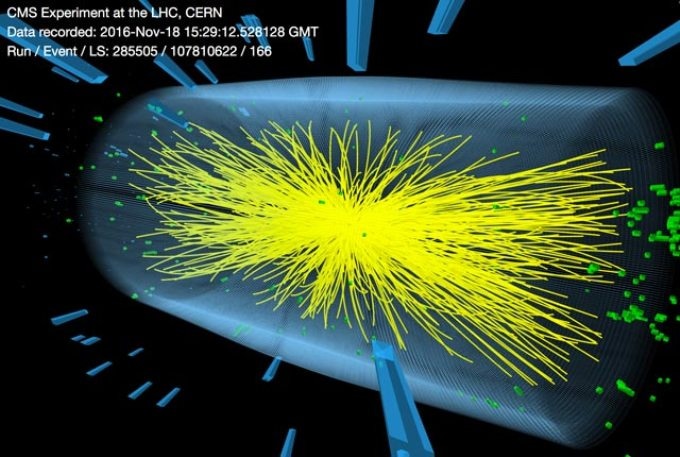Apr 11 2017
Rice University physicists probe exotic state of nuclear matter at Europe’s LHC
 A visual of data collected by the Compact Muon Solenoid detector during a proton-lead collision at the Large Hadron Collider in 2016. (Image courtesy of Thomas McCauley/CERN)
A visual of data collected by the Compact Muon Solenoid detector during a proton-lead collision at the Large Hadron Collider in 2016. (Image courtesy of Thomas McCauley/CERN)
Findings from Rice University physicists working at Europe’s Large Hadron Collider (LHC) are providing new insight about an exotic state of matter called the “quark-gluon plasma” that occurs when protons and neutrons melt.
As the most powerful particle accelerator on Earth, the LHC is able to smash together the nuclei of atoms at nearly the speed of the light. The energy released in these collisions is vast and allows physicists to recreate the hot, dense conditions that existed in the early universe. Quark-gluon plasma, or QGP, is a high-energy soup of particles that’s formed when protons and neutrons melt at temperatures approaching several trillion kelvins.
In a recent paper in Physical Review Letters written on behalf of more than 2,000 scientists working on the LHC’s Compact Muon Solenoid (CMS) experiment, Rice physicists Wei Li and Zhoudunming (Kong) Tu proposed a new approach for studying a characteristic magnetic property of QGP called the “chiral magnetic effect” (CME). Their approach uses collisions between protons and lead nuclei. CME is an electromagnetic phenomenon that arises as a consequence of quantum mechanics and is also related to so-called topological phases of matter, an area of condensed matter physics that has drawn increased worldwide attention since capturing the Nobel Prize in physics in 2016.
“To find evidence for the chiral magnetic effect and thus topological phases in hot QGP matter has been a major goal in the field of high-energy nuclear physics for some time,” Li said. “Early findings, although indicative of the CME, still remain inconclusive, mainly because of other background processes that are difficult to control and quantify.”
QGP was first produced around 2000 at the Relativistic Heavy Ion Collider in New York and later at the LHC in 2010. In those experiments, physicists smashed together two fast-moving lead nuclei, each of containing 82 protons and 126 neutrons, the two building blocks of all atomic nuclei. Because the melting protons in these collisions each carries a positive electric charge, the QGPs from these experiments contained enormously strong magnetic fields, which are estimated to be about a trillion times stronger than the strongest magnetic field ever created in a laboratory.
The chiral magnetic effect is an exotic asymmetric electromagnetic effect that only arises due to the combination of quantum mechanics and the extreme physical conditions in a QGP. The laws of classical electrodynamics would forbid the existence of such a state, and indeed, Li’s inspiration for the new experiments arose from thinking about the problem in classical terms.
“I was inspired by a problem in an undergraduate course I was teaching on classical electrodynamics,” Li said.
Two years ago Li discovered that head-on collisions at LHC between a lead nucleus and a single proton created small amounts of particles that appeared to behave as a liquid. On closer analysis, he and colleagues at CMS found the collisions were creating small amounts of QGP.
In a 2015 Rice News report about the discovery, Rice alumnus Don Lincoln, a particle physicist and physics communicator at Fermilab, wrote, “This result was surprising because when the proton hits the lead nucleus, it punches a hole through much of the nucleus, like shooting a rifle at a watermelon (as opposed to colliding two lead nuclei, which is like slamming two watermelons together).”
Li said, “One unusual thing about the droplets of QGP created in proton-lead collisions is the configuration of their magnetic fields. The QGP is formed near the center of the initial lead nucleus, which makes it easy to tell that the strength of the magnetic field is rather negligible in comparison with the QGP created in lead-lead collisions. As a result, proton-lead collisions provide us a means to switch off the magnetic field — and the CME signal — in a QGP in a well-controlled way.”
In the new paper, Li, Tu and their CMS colleagues showed evidence from proton-lead collision data that helps shed light on the electromagnetic behaviors that arise from the chiral magnetic effect in lead-lead QGPs.
Li said more details still need to be worked out before a definitive conclusion can be drawn, but he said the results bode well for future QGP discoveries at the LHC.
“This is just a first step in a new avenue opened up by proton-nucleus collisions for the search of exotic topological phases in QGP,” Li said. “We are working hard on accumulating more data and performing a series of new studies. Hopefully, in coming years, we will see the first direct evidence for the chiral magnetic effect.”
The research is supported by the Department of Energy and the National Science Foundation.
Quark Gluon Plasma